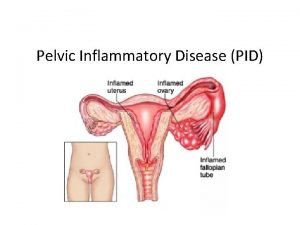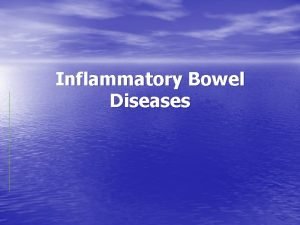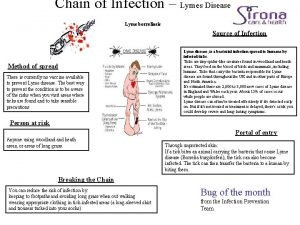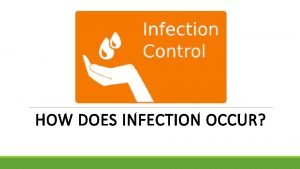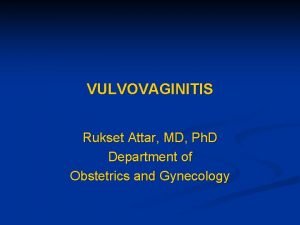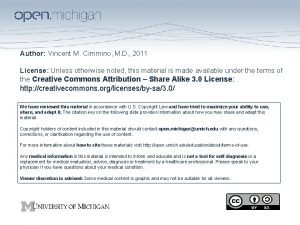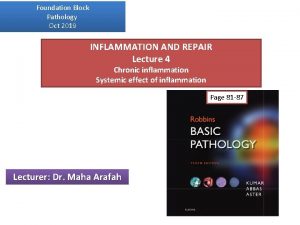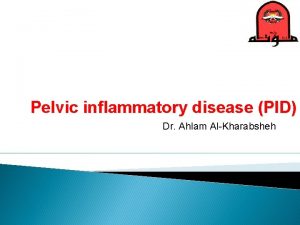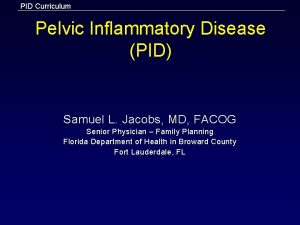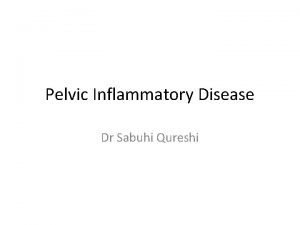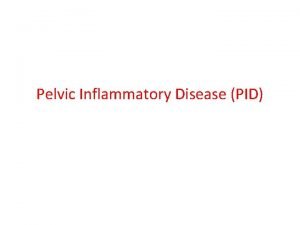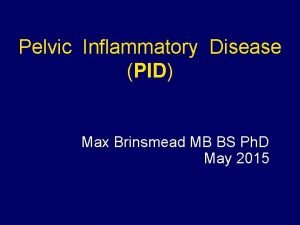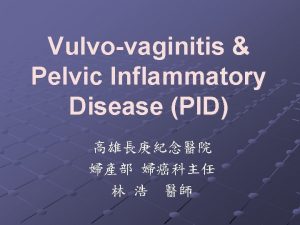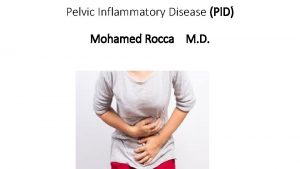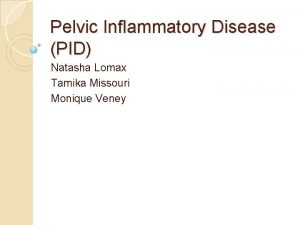Pelvic inflammatory disease infection Involve PID is a












- Slides: 12

- Pelvic inflammatory disease infection Involve - (PID) is a generic term for inflammation of the uterus( (endmetritis), fallopian tubes (salpingitis), and/or ovaries(overitis) as it progresses to scar formation with adhesions to nearby tissues and organs. -This may lead to infections. PID is a vague term and can refer to viral, fungal, parasitic, women with abortion , IUD, and multiparity are at high risk. Most often bacterial infection is the cause of PID should be classified by affected organs, the stage of the infection, and the organism(s) causing it. Although an STI is often the cause, many other routes are possible, including lymphatic, postpartum, postabortal(either miscarriage or abortion) or intrauterine device (IUD) related, and hematogenous spread. Two thirds of patients with laparoscopic evidence of previous PID were not aware they had PID.

-PID woman is high risk for : ectopic pregnancy, infertility, chronic pelvic pain, dyspareunia pyosalpinx (pus in uterine tube ), pelvic adhesion or abscess Epidemiology In the United States, more than a million women are affected by PID each month, and the rate is highest with teenagers and first time mothers. PID causes over 100, 000 women to become infertile in the US each year. N. gonorrhea is isolated in 40 -60% of women with acute salpingitis. trachomatis is estimated to be the cause in about 60% of cases of salpingitis, which may lead to PID. However, not all PID is caused solely by STIs; organisms that are considered normal vaginal flora can be involved, and individual cases of PID can be due to either a single organism or a co-infection of many different species. It was noted in one study that 10 -40% of untreated women with N. gonorrhoea develop PID and 20 -40% of women infected with C. trachomitis developed PID is the leading cause of infertility. "A single episode of PID results in infertility in 13% of women, This rate of infertility increases with each infection.

Symptoms PID range from sub clinical (asymptomatic) to severe. If there are symptoms then fever, cervical motion tenderness, lower abdominal, new or different discharge, painful intercourse, or irregular menstrual bleeding may be noted. It is important to note that even asymptomatic PID can and does cause serious harm. Laparoscopic identification is helpful in diagnosing tubal disease, 65 -90% positive predictive value in patients with presumed PID. Regular Sexually Transmitted Infection (STI) testing is important for prevention. Treatment is usually started empirically because of the serious complications that may result from delayed treatment. Definitive criteria include: histopathologic evidence of endometritis, thickened filled fallopian tubes, or laparoscopic findings. Gramstain/smear becomes important in identification of rare and possibly more serious organisms.

Differential diagnosis Appendicitis, ectopic pregnancy, septic abortion, hemorrhagic or ruptured ovarian cysts or tumors, twisted ovarian cyst, degeneration of amyoma. Pelvic inflammatory disease is expected when there is a history of pelvic inflammatory disease, recent sexual contact, recent onset of menses, or an IUD in place or if the partner has a sexually transmitted infection. - A sensitive serum pregnancy test should be obtained to rule out ectopic pregnancy. Culdocentesis will differentiate peritoneum (ruptured ectopic pregnancy or hemorrhagic cyst) from pelvic sepsis (salpingitis, ruptured pelvic abscess, or ruptured appendix). -Pelvic and vaginal ultrasounds are helpful in the differential diagnosis of ectopic pregnancy of over six weeks. Laparoscopy is often utilized to diagnose pelvic inflammatory disease, and it is imperative if the diagnosis is not certain or if the patient has not responded to antibiotic therapy after 48 hours.

Although the PID infection itself may be cured, effects of the infection may be permanent. This makes early identification by someone who can prescribe appropriate curative treatment very important in the prevention of damage to the reproductive system. Since early gonococcal infection may be asymptomatic, regular screening of individuals at risk for common agents of certain procedures (post pelvic operation, postpartum, miscarriage or abortion). Prevention is also very important in maintaining viable reproduction capabilities. -If the initial infection is mostly in the lower tract, after treatment the person may have few difficulties. If the infection is in the fallopian tubes or ovaries, more serious complications are more likely to occur.

Complications PID can cause scarring inside the reproductive organs, which can later cause serious complications, including chronic pelvic pain, infertility, ectopic pregnancy (the leading cause of pregnancy -related deaths in adult females), and other dangerous complications of pregnancy. Occasionally, the infection can spread to in the peritoneum causing inflammation and the formation of scar tissue on the external surface of the liver (Fitz. Hugh-Curtis syndrome). Multiple infections and infections that are treated later are more likely to result in complications. -Fertility may be restored in women affected by PID. Traditionally tuboplastic surgery was the main approach to correct tubal obstruction or adhesion formation, however success rates tended to be very limited. In vitro fertilization (IVF) has been used to bypass tubal problems and has become the main treatment for patients who want to become pregnant.

Treatment depends on the cause and generally involves use of antibiotic therapy. If the patient has not improved within two to three days after beginning treatment with the antibiotics, they should return to the hospital for further treatment. Drugs should also be given orally and/or intravenously to the patient while in the hospital to begin treatment immediately, and to increase the effectiveness of antibiotic treatment. Hospitalization may be necessary if the patient has Tubo-ovarian abscesses; is very ill, immunodeficient, pregnant, or incompetent; or because a lifethreatening condition cannot be ruled out. Treating partners for STIs is a very important part of treatment and prevention. Anyone with PID and partners of patients with PID since six months prior to -diagnosis should be treated to prevent reinfection.

Psychotherapy is highly recommended to women diagnosed with PID as the fear of redeveloping the disease after being cured may exist. It is important for a patient to communicate any issues and/or uncertainties they may have to a doctor, especially a specialist such as a gynecologist, and in doing so, to seek follow-up care. -A systematic review of the literature related to PID treatment was performed prior to the 2006 CDC sexually transmitted infections treatment guidelines. Strong evidence suggests that neither site nor route of antibiotic administration affects the short or long-term major outcome of women with mild or moderate disease. Data on women with severe disease was inadequate to influence the results of the study. Drugs : include cefoxitin or cefotetan plus, doxycycline, clindamycin plus, gentamicin, ampicillin and sulbactam plus doxycycline, andceftriaxone or cefoxitin plus doxycycline

Prevention Risk reduction against sexually transmitted infections through barrier methods such as condoms or abstinence; see human sexual behavior for other listings. Going to the doctor immediately if symptoms of PID, sexually transmitted infections appear, or after learning that a current or former sex partner has, or might have had a sexually transmitted infection. Getting regular gynecological (pelvic) exams with STI testing to screen for symptom less PID. Discussing sexual history with a trusted physician in order to get properly screened for sexually transmitted diseases.

Prevention Regularly scheduling STI testing with a physician and discussing which tests will be performed that session. Getting a STI history from your current partner and insisting they be tested and treated before intercourse. Understanding when a partner says that they have been STI tested they usually mean Chlamydia and gonorrhea in the US, but that those are not all of the sexually transmissible infections. Treating partners to prevent reinfection or spreading the infection to other people.

Prevention Regularly scheduling STI testing with a physician and discussing which tests will be performed that session. Getting a STI history from your current partner and insisting they be tested and treated before intercourse. Understanding when a partner says that they have been STI tested they usually mean Chlamydia and gonorrhea in the US, but that those are not all of the sexually transmissible infections. Treating partners to prevent reinfection or spreading the infection to other people.

THANKS FOR YOUR ATTENTION
 Pelvic inflammatory disease men
Pelvic inflammatory disease men Pelvic girdle pain
Pelvic girdle pain Multi loop pid controller regolatore pid multi loop
Multi loop pid controller regolatore pid multi loop Iliocolitis
Iliocolitis Chain of infection for lyme disease
Chain of infection for lyme disease Chapter 19 disease transmission and infection prevention
Chapter 19 disease transmission and infection prevention Puncture resistant container
Puncture resistant container Diseases spread by pathogens
Diseases spread by pathogens Chapter 19 disease transmission and infection prevention
Chapter 19 disease transmission and infection prevention Pro and anti inflammatory
Pro and anti inflammatory Mucorrhea causes
Mucorrhea causes Treatment of inflammatory breast cancer
Treatment of inflammatory breast cancer Inflammatory cells
Inflammatory cells

